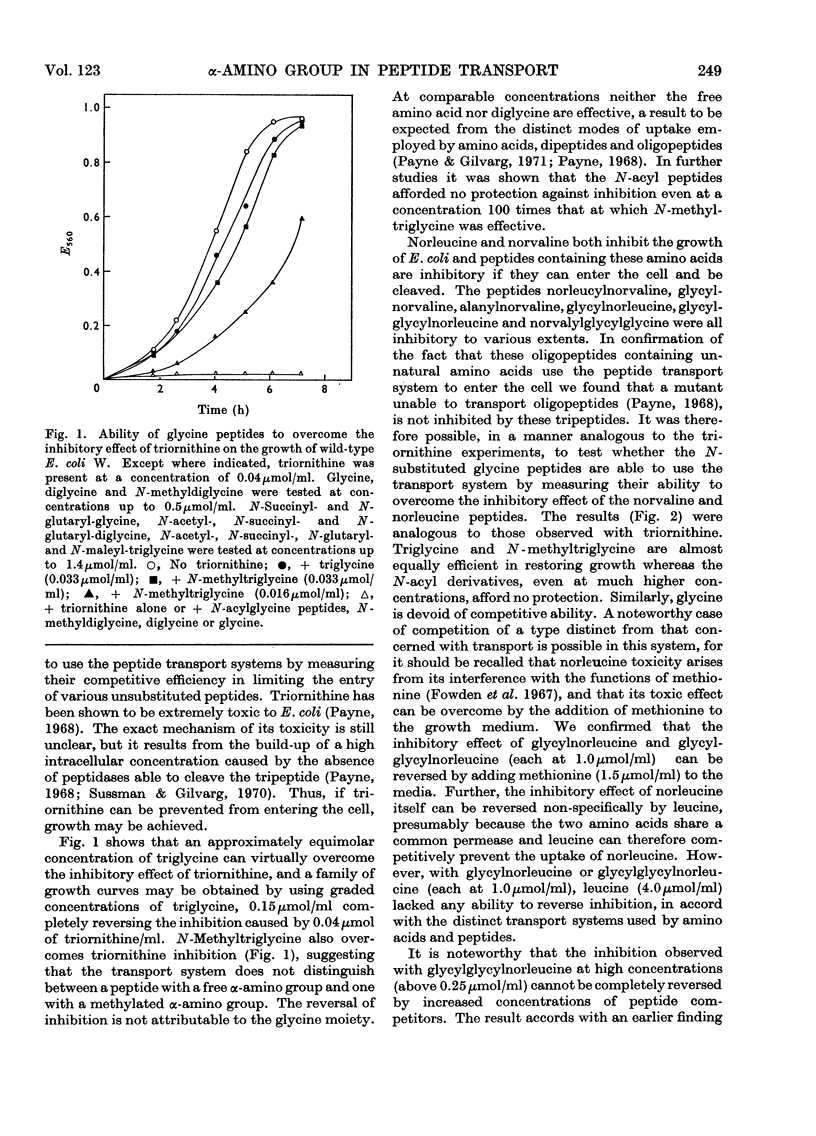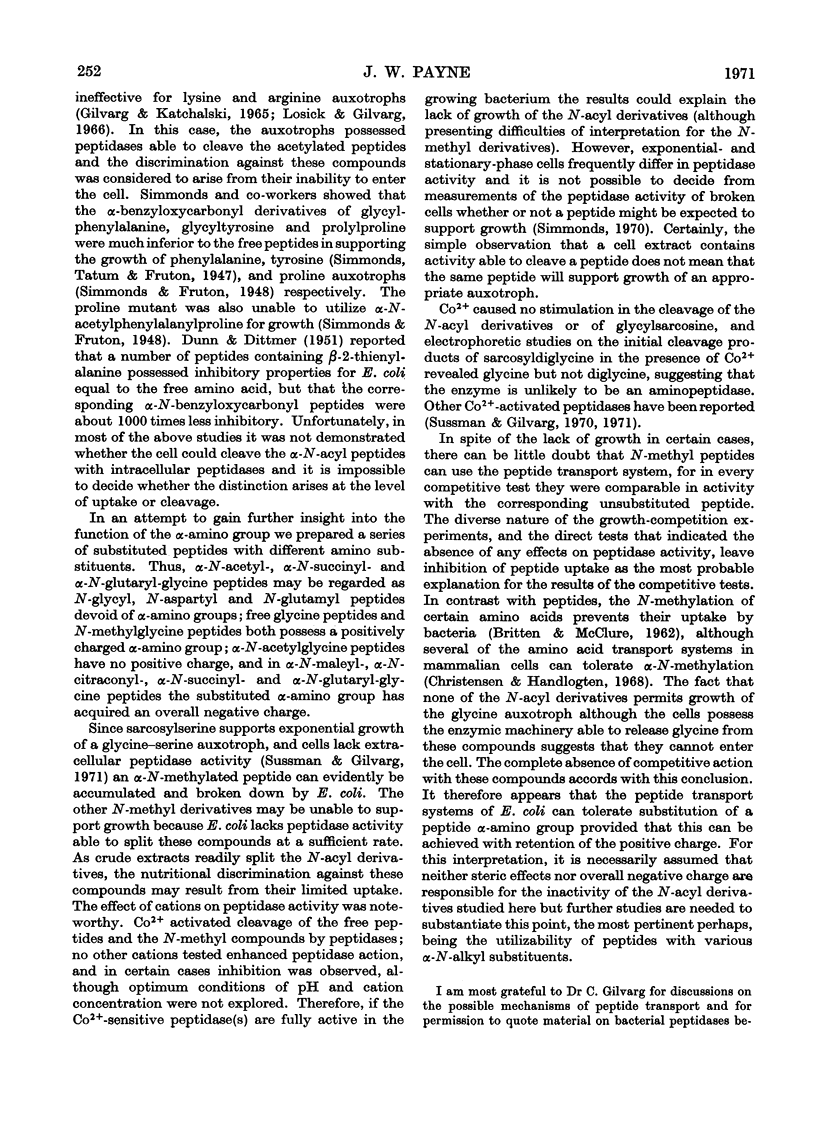Abstract
Many glycine peptides support growth of a glycine auxotroph of Escherichia coli. If the α-amino group of these peptides is methylated, the products are still utilized for growth, and also retain comparable ability with the unsubstituted peptides to compete with natural peptides for transport into the cell. In contrast, glycine peptides devoid of an α-amino group, or that have the α-amino group substituted by one of a number of acyl groups are not utilized, although E. coli possesses intracellular enzymic activity able to release glycine from such compounds; further, these derivatives do not compete with natural peptides for transport into the cell.
Full text
PDF








Selected References
These references are in PubMed. This may not be the complete list of references from this article.
- BRITTEN R. J., McCLURE F. T. The amino acid pool in Escherichia coli. Bacteriol Rev. 1962 Sep;26:292–335. doi: 10.1128/br.26.3.292-335.1962. [DOI] [PMC free article] [PubMed] [Google Scholar]
- Christensen H. N., Handlogten M. E. Modes of mediated exodus of amino acids from the Ehrlich ascites tumor cell. J Biol Chem. 1968 Oct 25;243(20):5428–5438. [PubMed] [Google Scholar]
- DAVIS B. D. Biosynthetic interrelations of lysine, diaminopimelic acid, and threonine in mutants of Escherichia coli. Nature. 1952 Mar 29;169(4300):534–536. doi: 10.1038/169534a0. [DOI] [PubMed] [Google Scholar]
- DAVIS B. D., MINGIOLI E. S. Mutants of Escherichia coli requiring methionine or vitamin B12. J Bacteriol. 1950 Jul;60(1):17–28. doi: 10.1128/jb.60.1.17-28.1950. [DOI] [PMC free article] [PubMed] [Google Scholar]
- DEWEY D. L., WORK E. Diaminopimelic acid decarboxylase. Nature. 1952 Mar 29;169(4300):533–534. doi: 10.1038/169533a0. [DOI] [PubMed] [Google Scholar]
- DUNN F. W., DITTMER K. The synthesis and microbiological properties of some peptide analogues. J Biol Chem. 1951 Jan;188(1):263–272. [PubMed] [Google Scholar]
- Dixon H. B., Perham R. N. Reversible blocking of amino groups with citraconic anhydride. Biochem J. 1968 Sep;109(2):312–314. doi: 10.1042/bj1090312. [DOI] [PMC free article] [PubMed] [Google Scholar]
- Fowden L., Lewis D., Tristram H. Toxic amino acids: their action as antimetabolites. Adv Enzymol Relat Areas Mol Biol. 1967;29:89–163. doi: 10.1002/9780470122747.ch3. [DOI] [PubMed] [Google Scholar]
- GILVARG C., KATCHALSKI E. PEPTIDE UTILIZATION IN ESCHERICHIA COLI. J Biol Chem. 1965 Jul;240:3093–3098. [PubMed] [Google Scholar]
- HEILMANN J., BARROLLIER J., WATZKE E. Beitrag zur Aminosäurebestimmung auf Papierchromatogrammen. Hoppe Seylers Z Physiol Chem. 1957;309(4-6):219–220. [PubMed] [Google Scholar]
- LEAVITT R. I., UMBARGER H. E. Isoleucine and valine metabolism in Escherichia coli. XI. Valine inhibition of the growth of Escherichia coli strain K-12. J Bacteriol. 1962 Mar;83:624–630. doi: 10.1128/jb.83.3.624-630.1962. [DOI] [PMC free article] [PubMed] [Google Scholar]
- Losick R., Gilvarg C. Effect of alpha-acetylation on utilization of lysine oligopeptides in Escherichia coli. J Biol Chem. 1966 May 25;241(10):2340–2346. [PubMed] [Google Scholar]
- Offord R. E. Electrophoretic mobilities of peptides on paper and their use in the determination of amide groups. Nature. 1966 Aug 6;211(5049):591–593. doi: 10.1038/211591a0. [DOI] [PubMed] [Google Scholar]
- Payne J. W., Gilvarg C. Size restriction on peptide utilization in Escherichia coli. J Biol Chem. 1968 Dec 10;243(23):6291–6299. [PubMed] [Google Scholar]
- Payne J. W., Gilvarg C. The role of the terminal carboxyl group on peptide transport in Escherichia coli. J Biol Chem. 1968 Jan 25;243(2):335–340. [PubMed] [Google Scholar]
- Payne J. W. Oligopeptide transport in Escherichia coli. Specificity with respect to side chain and distinction from dipeptide transport. J Biol Chem. 1968 Jun 25;243(12):3395–3403. [PubMed] [Google Scholar]
- STEWART J. W., STAHMANN M. A. The chromatography of polylysine. J Chromatogr. 1962 Oct;9:233–235. doi: 10.1016/s0021-9673(00)80766-9. [DOI] [PubMed] [Google Scholar]
- Shimura Y., Vogel H. J. Diaminopimelate decarboxylase of Lemna perpusilla: partial purification and some properties. Biochim Biophys Acta. 1966 May 5;118(2):396–404. doi: 10.1016/s0926-6593(66)80048-6. [DOI] [PubMed] [Google Scholar]
- Sussman A. J., Gilvarg C. Peptidases in Escherichia coli K-12 capable of cleaving lysine homopeptides. J Biol Chem. 1970 Dec 25;245(24):6518–6524. [PubMed] [Google Scholar]
- VON ARX, NEHER R. EINE MULTIDIMENSIONALE TECHNIK ZUR CHROMATOGRAPHISCHEN IDENTIFIZIERUNG VON AMINOSAEUREN. J Chromatogr. 1963 Nov;12:329–341. doi: 10.1016/s0021-9673(01)83693-1. [DOI] [PubMed] [Google Scholar]
- Vogt V. M. Purification and properties of an aminopeptidase from Escherichia coli. J Biol Chem. 1970 Sep 25;245(18):4760–4769. [PubMed] [Google Scholar]
- WIESMEYER H., COHN M. The characterization of the pathway of maltose utilization by Escherichia coli. I. Purification and physical chemical properties of the enzyme amylomaltase. Biochim Biophys Acta. 1960 Apr 22;39:417–426. doi: 10.1016/0006-3002(60)90194-3. [DOI] [PubMed] [Google Scholar]


